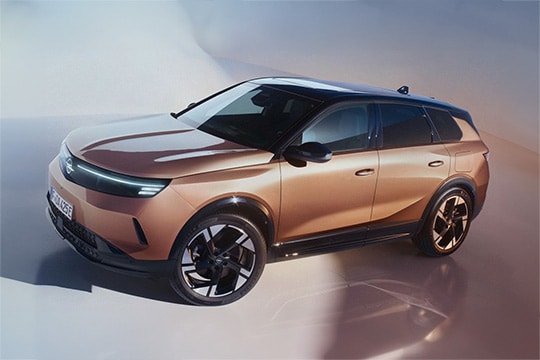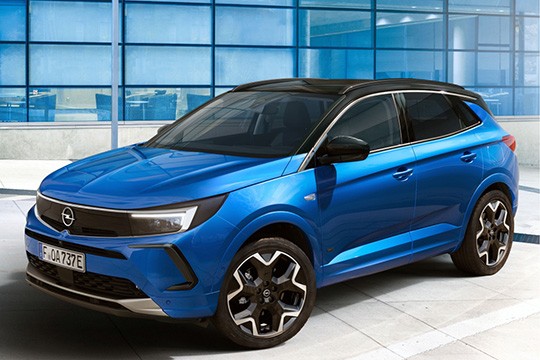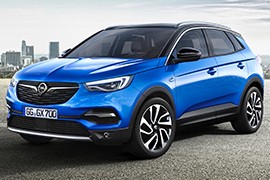OPEL Grandland Models/Series Timeline, Specifications & Photos
First production year: 2017
Engines: Electric, Gasoline, Diesel, Hybrid gasoline, Plug-in hybrid, Hybrid
Body style: SUV (Sports Utility Vehicle)
Opel introduced the second generation of the Grandland in the spring of 2024, offering customers a medium-sized European crossover with a choice of hybrid, plug-in hybrid, or electric-only drivetrains.
The first generation of the Grandland shared its EMP2 platform with several other French vehicles, such as the Peugeot 3008/5008, Citroen C5 Aircross, and DS7 Crossback. While the German automaker was under GM’s umbrella since 1929, it sold it to the French industrial group PSA (Peugeot-Citroen) in 2017. As a result, Opel became part of the Stellantis Group, sitting at the same table as Chrysler and Dodge. The 2024 Grandland still shared its underpinnings with other vehicles within Stellantis, being built on the third generation of the STLA Medium platform, shared only with the third generation of the Peugeot 3008, which was introduced in March 2024.
The new generation continued the design modifications introduced by Opel on the facelifted version of the Grandland in 2021. It featured the same visor design (named 3D Vizor), which mimicked a knight helmet with a narrow opening for their eyes, in Grandland’s case, the headlights. The German car manufacturer created new Intelli-Lux Pixel Matrix HD headlamps that integrated 51,200 LEDs (25,600 on each side). Its predecessor had only 84 LEDs per side. Furthermore, the Opel logo was illuminated. Underneath the black panel, the automaker installed a fat bumper that sported a pair of side scoops and had a black lower grille on its lower side.
Opel made the Grandland longer, taller, and wider than its predecessor. But still, the vehicle’s profile resembled the facelifted version of its predecessor. The tall side panels, sculptured doors, ascending waistline, and wider rear fenders made the crossover look dynamic. At the back, the racked-forward D-pillars supported a black roof, which was a design element introduced by Opel more than a decade before on the Astra lineup. A set of black trims adorned the rounded wheel arches and the side sills, creating the visual illusion of a vehicle with a higher ground clearance. Out back, the taillights echoed the shape of the headlights, and the automaker placed a red LED stripe that crossed the vehicle from side to side over the tailgate. Last but not least, as a final styling touch, the tailgate sported the Grandland lettering stamped on the metallic side of the lower area.
Inside the cabin, Opel packed the Grandland with smart solutions and advanced technologies in a blend that should satisfy any family. Up front, the automaker installed a ten-inch TFT display in front of the driver for the instrument cluster, while atop the center stack, the automaker placed a wide, 16-inch touchscreen for the infotainment unit. Underneath it, the automaker placed a storage fitted with a sliding lid that concealed a wireless charger and two USB-C ports. The front seats were certified by AGR (Campaign for Healthy Backs) and included powered bolsters. In the back, a split folding bench seat with a retractable armrest that featured two cup holders and a slot for a tablet ensured that those sited there would enjoy the ride. Behind, the trunk could hold 550 liters (19.4 cu-ft) of luggage.
Opel offered the Grandland with three drivetrains: a hybrid, a plug-in hybrid, and an all-electric version. The latter boasted a 700 km (435 miles) range thanks to its large 98 kWh battery pack.
Opel revealed the refreshed 2021, Grandland crossover built on the same platform as its brother Peugeot 3008 and showed a serious visual upgrade.
Sometimes, a carmaker manages to unveil a facelift that looks like a wholly new generation but still calls it a refresh since most of its underpinnings are the same as on the non-facelifted version. That's the case with the 2021 Grandland, which jumped from the modest-looking 2017 model to an exciting 2021 model.
Since most customers are looking at a car's front fascia when they want to buy one, Opel designers mainly focused on that area. It kept the same 90 degrees LED daytime running lights pattern but with a sharper look. Its 168 LED headlights (84 per lamp) and black front panel mimicked the face of an electric vehicle. A new grille-mounted in the lower side of the bumper took the cooling job, which sported a 3D pattern and a lower lip spoiler. A pair of vertical air-intakes on the sides gave the crossover a sportier look. At the back, Opel designers look like they lost their appetite for changing and installed slightly redesigned taillights with LEDs and placed wide chromed lettering on the tailgate with the "Grandland" word.
Inside, there was a new dashboard design with two displays. The touch-screen that sat on top of the center was for the infotainment system, while the up to 10" LCD in front of the driver served as an instrument panel. Like its predecessor, the seats were certified by the "Aktion Gesunder Rücken e.V." (campaign for healthy backs) for their ergonomic shape.
Under the hood, Opel carried over drivetrains from Peugeot-Citroen. It also featured a hybrid system that used the internal combustion engine to power the front wheels and an electric motor for the rear axle.
Opel introduced the Grandland X in 2017 as a replacement for the already old Antara SUV, and it built it under the new PSA management.
After GM sold Opel and Vauxhall to the French carmaker Peugeot, the new owner started to dictate its cost-cutting measures. One of them was introducing a new SUV based on the same PSA EMP2 platform as the Peugeot 3008/Citroen C5 Aircross. Unlike the Antara, the Grandland X was no longer all-wheel-drive, but since most European customers bought 2WD SUVs, that wasn't a problem. Yet, if they really wished an all-wheel-drive version, Opel introduced, later on, two hybrid versions.
Despite sharing more parts with the Peugeot and Citroen, Opel managed to keep its identity. It featured a pair of swept-back headlights that incorporated the LED daytime running lights with a design that resembled the Insignia. Its black grille with a 3D pattern sported a chromed bar with the Opel badge in the middle, while on the sides, the sculptured doors looked similar to those from the Astra. The car's designers made a floating-roof look at the back, with a D-pillar blackened on its upper side.
Inside, the Grandland X featured an analog instrument panel with two wide dials on the sides flanking a TFT screen between them and two gauges on above them. Opel installed a touch-screen infotainment system with screen mirroring, Apple CarPlay, and Android auto depending on the trim level and options. The German carmaker designed the front bucket seats, which provided good comfort, while in the back, the split-folding bench could accommodate three people.
Under the hood, Peugeot installed a wide engine range between a fuel-efficient, but sluggish, 1.2-liter turbocharged unit. There were also two turbo-diesel versions and two hybrids.


